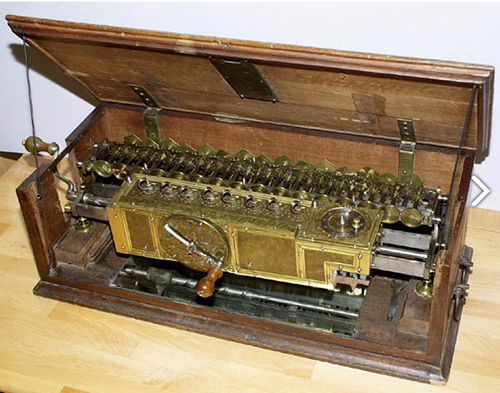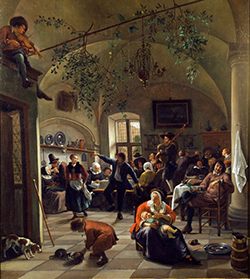MENU
The Electronic Scholarly Publishing Project: Providing access to classic scientific papers and other scholarly materials, since 1993. More About: ESP | OUR CONTENT | THIS WEBSITE | WHAT'S NEW | WHAT'S HOT
Comparative Timelines
The ESP Timeline (one of the site's most popular features) has been completely updated to allow the user to select (using the timeline controls above each column) different topics for the left and right sides of the display.
Select:
New Left Column
New Left Column
Dates
Decade
New Right Column
New Right Column
1670
The Hudson Bay Company is incorporated.
The State of Virginia prohibits free blacks and Indians from keeping Christian (i.e. white) servants.
(no entry for this year)
1671
(no entry for this year)
(no entry for this year)
1672
 Gottfried Wilhelm von Leibniz invents the Staffelwalze (stepped drum, or stepped reckoner), the first mechanical calculator that could perform all four mathematical operations. Its intricate precision gearwork, however, was somewhat beyond the fabrication technology of the time; mechanical problems, in addition to a design flaw in the carry mechanism, prevented the machines from working reliably. Despite the mechanical flaws, it suggested possibilities to future calculator builders. The operating mechanism, invented by Leibniz, called the stepped cylinder or Leibniz wheel, was used in many calculating machines for 200 years, and into the 1970s with the Curta hand calculator. In discussing his invention, Leibniz wrote Indignum enim est excellentium virorum horas servii calculandi labore perire, qui Machina adhibita vilissimo cuique secure transcribi posset — For it is unworthy of distinguished men to waste their time with slavish calculations, which can be done safely with the use of this machine by anyone else.
Gottfried Wilhelm von Leibniz invents the Staffelwalze (stepped drum, or stepped reckoner), the first mechanical calculator that could perform all four mathematical operations. Its intricate precision gearwork, however, was somewhat beyond the fabrication technology of the time; mechanical problems, in addition to a design flaw in the carry mechanism, prevented the machines from working reliably. Despite the mechanical flaws, it suggested possibilities to future calculator builders. The operating mechanism, invented by Leibniz, called the stepped cylinder or Leibniz wheel, was used in many calculating machines for 200 years, and into the 1970s with the Curta hand calculator. In discussing his invention, Leibniz wrote Indignum enim est excellentium virorum horas servii calculandi labore perire, qui Machina adhibita vilissimo cuique secure transcribi posset — For it is unworthy of distinguished men to waste their time with slavish calculations, which can be done safely with the use of this machine by anyone else.
(no entry for this year)
1673
The Mississippi River is discovered.
 Painting by Jan Steen: Merrymaking at an Inn combines the Flemish tradition of low-life tavern scenes with the more elegant Dutch merry companies.
Painting by Jan Steen: Merrymaking at an Inn combines the Flemish tradition of low-life tavern scenes with the more elegant Dutch merry companies.
1674
New York declares that blacks who convert to Christianity after their enslavement will not be freed.
(no entry for this year)
1675
King Philip's War (sometimes called the First Indian War, Metacom's War, Metacomet's War, or Metacom's Rebellion) begins in New England. The war was an armed conflict between American Indian inhabitants of present-day New England and English colonists and their Indian allies in 1675 78. The war is named for Metacomet, the Wampanoag chief who adopted the English name Philip due to the friendly relations between his father and the Mayflower Pilgrims. The war continued in the most northern reaches of New England until the signing of the Treaty of Casco Bay in April 1678. The war was the single greatest calamity to occur in seventeenth century Puritan New England and is considered by many to be the deadliest war in the history of European settlement in North America in proportion to the population. In the space of little more than a year, twelve of the region's towns were destroyed and many more damaged, the colony's economy was all but ruined, and its population was decimated, losing one-tenth of all men available for military service. More than half of New England's towns were attacked by Indians. By early July, over 400 had surrendered to the colonists, and Metacomet took refuge in the Assowamset Swamp below Providence, close to where the war had started. The colonists formed raiding parties of militia and Indians. They were allowed to keep the possessions of warring Indians and received a bounty on all captives. Metacomet was killed by one of these teams when he was tracked down by Captain Benjamin Church and Captain Josiah Standish of the Plymouth Colony militia at Mount Hope in Bristol, Rhode Island. He was shot and killed by an Indian named John Alderman on August 12, 1676. After his death, his wife and nine-year-old son were captured and sold as slaves in Bermuda. Philip's head was mounted on a pike at the entrance to Fort Plymouth, where it remained for more than two decades. His body was cut into quarters and hung in trees. Alderman was given Metacomet's right hand as a reward.
(no entry for this year)
1676
In Virginia, black slaves and black and white indentured servants band together to participate in Bacon's Rebellion.
(no entry for this year)
1677
(no entry for this year)
(no entry for this year)
1678
The Treaty of Nijmegen ends various interconnected wars among France, the Dutch Republic, Spain, Brandenburg, Sweden, Denmark, the Prince-Bishopric of M nster, and the Holy Roman Empire.
(no entry for this year)
1679
The habeas corpus act is passed in England.
ESP Quick Facts
ESP Origins
In the early 1990's, Robert Robbins was a faculty member at Johns Hopkins, where he directed the informatics core of GDB — the human gene-mapping database of the international human genome project. To share papers with colleagues around the world, he set up a small paper-sharing section on his personal web page. This small project evolved into The Electronic Scholarly Publishing Project.
ESP Support
In 1995, Robbins became the VP/IT of the Fred Hutchinson Cancer Research Center in Seattle, WA. Soon after arriving in Seattle, Robbins secured funding, through the ELSI component of the US Human Genome Project, to create the original ESP.ORG web site, with the formal goal of providing free, world-wide access to the literature of classical genetics.
ESP Rationale
Although the methods of molecular biology can seem almost magical to the uninitiated, the original techniques of classical genetics are readily appreciated by one and all: cross individuals that differ in some inherited trait, collect all of the progeny, score their attributes, and propose mechanisms to explain the patterns of inheritance observed.
ESP Goal
In reading the early works of classical genetics, one is drawn, almost inexorably, into ever more complex models, until molecular explanations begin to seem both necessary and natural. At that point, the tools for understanding genome research are at hand. Assisting readers reach this point was the original goal of The Electronic Scholarly Publishing Project.
ESP Usage
Usage of the site grew rapidly and has remained high. Faculty began to use the site for their assigned readings. Other on-line publishers, ranging from The New York Times to Nature referenced ESP materials in their own publications. Nobel laureates (e.g., Joshua Lederberg) regularly used the site and even wrote to suggest changes and improvements.
ESP Content
When the site began, no journals were making their early content available in digital format. As a result, ESP was obliged to digitize classic literature before it could be made available. For many important papers — such as Mendel's original paper or the first genetic map — ESP had to produce entirely new typeset versions of the works, if they were to be available in a high-quality format.
ESP Help
Early support from the DOE component of the Human Genome Project was critically important for getting the ESP project on a firm foundation. Since that funding ended (nearly 20 years ago), the project has been operated as a purely volunteer effort. Anyone wishing to assist in these efforts should send an email to Robbins.
ESP Plans
With the development of methods for adding typeset side notes to PDF files, the ESP project now plans to add annotated versions of some classical papers to its holdings. We also plan to add new reference and pedagogical material. We have already started providing regularly updated, comprehensive bibliographies to the ESP.ORG site.
ESP Picks from Around the Web (updated 06 MAR 2017 )
Old Science

Weird Science

Treating Disease with Fecal Transplantation
Fossils of miniature humans (hobbits) discovered in Indonesia

Dinosaur tail, complete with feathers, found preserved in amber.
Astronomy

Mysterious fast radio burst (FRB) detected in the distant universe.